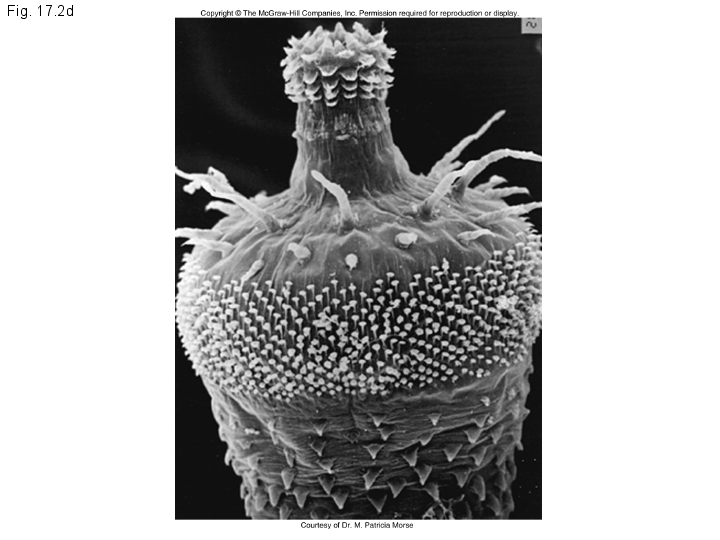


• All very small and interstitial or live between substrate structure or materials .
• The head which bears the recurved spines or scalids can be retracted into the trunk and is therefore called an 'introvert'. The head also bears an oral cone or mouth surrounded by more spines called stylets. The larvae of nematomorpha superficially resemble this group because they have scalids and an introvert. The Kinorhynchans move by thrusting the introvert forwards, the recurved spiny scalids serving as anchors, while the body segments are pulleded forward by circular muscles. They have circular and diagonal muscles.
- Pseudocoel, circular "brain" with ventral cord.
- Sexes separate but very little is known about their reproduction.
• But also: Repeating muscle units, and nerve ganglia along "segments" (cuticle, muscles and nerves) and protonephridia. Complete digestive sytem with muscular pharynx and anus. They molt periodically.
Notable characteristic:spiny cuticle divided into a fixed number of units.
No kinorhyncha fossils have yet been found. the outer segmentation of the trunk (always 13 segments) of the kinorhynchs is also seen in the serial repetition of ventral double ganglia suggests affinities with the next group we will study. Segmentation, epidermal glands and cross-striated muscles are otherwise only seen in ‘Panarthropoda’ (Tardigrada, Onychophora and Arthropoda). No such segmentation is found in the trunk of Priapulida and Loricifera although they do share other characteristics such as an introvert.

• A single-unit , non-cellular lorica composed of many, longitudinal plates with flexible junctions that is molted periodically.
• Remarkably large numbers of cells (10,000), muscles, scalids, etc. for such an extremely small animal


• Complex somewhat nematode-like life cycle with larva looks like adult, although has swimming appendages. Some have neoteny in life cycle.
Phylum Priapulida
• The largest, free-living cycloneuralians. The Priapulida, or Priapula are a small phylum (about 16 species known to scientists) of normally small worm like animals. They range in length from 0.5 mm for species of Tubuluchus to around 200 mm for species of Priapulus. They occur in most seas, both tropical and polar, at a variety of depths, from shallow coastal waters to as far down as 7,200 metres. They have a overall warty appearance and sausage-shaped body.The name Priapulida refers to the fact that the scientists who first named them thought they looked like a human penis,
• Share introvert scalids and chitinous cuticle with other Cycloneuralia. The cuticle is shed periodically.


• Complete gut, pharynx is eversible for feeding. The cells of the mid-gut possess microvilli.
• Several unique features support large size, including spacious hemocoel with amebocytes and pigmented cells. May be a true coelom, or well-developed pseudocoelom. In any case acts as a hydrostat with a role in controlling introvert and burrowing. Contraction of the circular muscles pressurizes the blood, causing the introvert and pharynx to extend and stretch the retractor (longitudinal) muscles. Contraction of the retractor muscles withdraws the introvert into the trunk.

• Have protonephridia but modified to form a paired stucture with gonads ( a urogenital organ) . Have radial cleavage, but molecular studies closely related to the two other cycloneuralia phyla having introverts.
• Abundant in Burgess Shale (520 mya, +). Fossils closely resemble modern forms.
Phylum Priapulida - 16 species found at one Cambrian fossil location
Acosmia maotiania (Chen & Zhou, 1997)
Archotuba conoidalis Hou et al., 1999
Corynetis brevis (Luo & Hu, 1999)
Gantoucunia aspera (Luo & Hu, 1999)
Lagenula triolata (Luo & Hu, 1999)
Oligonodus specialis (Luo & Hu, 1999)
Paraselkirkia jinningensis (Hou et al., 1999)
Palaeopriapulites parvus (Hou et al., 1999)
Protopriapulites haikouensis (Hou et al., 1999)
Sandaokania latinodosa (Luo & Hu, 1999)
Selkirkia elongata (Luo & Hu, 1999)
Selkirkia sinica (Luo & Hu, 1999)
Sicyophorus rarus (Luo & Hu, 1999)
Xiaoheiqingella peculiaris (Luo & Hu, 2002)
Xishania longgiusula (Lup & Hu, 2002)
Yunnanopriapulus halteroformis (Huang & Chen, 2004)
• Now sparse, with larger species mainly in polar oceans, smaller ones often interstitial.
The sexes are separate and there is normally only one ovary or testis. Eggs and sperm are released into the sea and fertilization occurs in the sea. The larva may lives in the mud like the adult, it is known to go through a number of molts before it takes on the adult form.